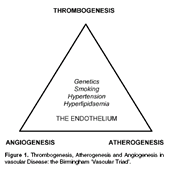Nearly 200 years ago, Virchow postulated a triad of abnormalities predisposing to thrombus formation (thrombogenesis), namely, abnormalities in blood flow, blood constituents, and the vessel wall - now referred to as 'Virchow’s triad'. The latter can now be considered by reference to the following: flow abnormalities and disturbances of haemorheology at bifurcations, irregular atheroma and/or stenotic regions (that is, “abnormal blood flow”); abnormalities in platelets, coagulation and fibrinolysis (“abnormal blood constituents”); and abnormalities in the endothelium or endocardium, or other structural heart disease (“abnormal vessel wall”).
The process of thrombogenesis is intimately related to atherogenesis. A common feature is the loss of endothelial cell integrity. Certainly, endothelial damage/dysfunction is crucial in atherosclerosis formation (atherogenesis). The process of angiogenesis is also evident in atherosclerotic vascular disease, as evident by vasa vasorum in the adventitia and media being at a higher density in atherosclerotic tissue, and commonly seen as greater neovascularisation leading to collateral growth bypassing obstruction and/or stenoses.
Whilst there is considerable evidence that atherogenesis and thrombogenesis are intimately linked, the abnormal angiogenesis in cardiovascular disease is a recently developed concept. We recently proposed a new 'vascular triad' of these abnormal pathophysiological processes, leading to an alternate view of the pathogenesis of vascular disease that links thrombogenesis, atherogenesis and angiogenesis (the Birmingham ‘Vascular Triad’, Figure 1) [1]. This new ‘triad’ of abnormalities is illustrated by recent work in hypertension and peripheral artery disease (see below).
Hypertension
Although hypertension is associated with the flow of blood under high pressures, yet the complications of hypertension, such as myocardial infarction or stroke are paradoxically thrombotic rather than haemorrhagic – the so-called “thrombotic paradox of hypertension”. Indeed, increasing evidence points towards a prothrombotic or hypercoagulable state in hypertension. However, the presence of abnormalities of indices associated with angiogenesis is increasingly recognised in hypertension.
In a substudy of the Anglo-Scandinavian Cardiac Outcomes Trial (ASCOT), measurement of indices of thrombogenesis, endothelial damage/dysfunction and angiogenesis demonstrated abnormal levels amongst hypertensives, when compared with the controls [2]. Importantly, all the research indices correlated with each other, and with both 10 year Framingham coronary heart disease risk and stroke risk scores (all p<0.001). Following a ‘package of care’ of intensified blood pressure and cardiovascular risk management, the research indices all near-normalised (all p<0.001). Thus, in subjects with hypertension and other risk factors, thrombogenesis, endothelial damage/dysfunction and angiogenesis are abnormal, and correlate with overall cardiovascular or stroke risk and importantly, can be closely related to each other, linking thrombogenesis, endothelial damage/dysfunction (a surrogate for atherogenesis) and angiogenesis.
Peripheral artery disease
Increasing evidence also points towards a prothrombotic state in atherosclerosis and its manifestations, such as peripheral artery disease [PAD], which is associated with many thrombosis-related complications such as acute limb ischaemia, graft thrombois and stroke[3]. Certainly, angiogenesis is evident in PAD, as clinically manifest by collateralisation of ischaemic limbs, and abnormal expression of vascular endothelial growth factor (VEGF, an angiogenic factor) in immunohistological studies of atherosclerotic arteries [4].
In a recent study of 234 patients with proven PAD, plasma levels of VEGF [p=0.001] and tissue factor (TF) [p=0.043] were also significantly increased in patients compared to controls [3]. There was significant correlations between VEGF and TF levels in both patients [Spearman r=0.351, p<0.001] and healthy controls [Spearman r=0.335, p=0.017], suggesting a link between the hypercoagulable state in atherosclerosis (PAD) and the process of angiogenesis.

Conclusion
Clearly, this is an exciting and developing field that highlights the increasingly recognised role for angiogenesis in vascular disease. Increasing evidence suggests that angiogenesis is an important aspect of the pathophysiology of cardiovascular disease, impacting with both thrombogenesis and atherogenesis, in a new vascular triad. Measurement of these pathophysiological indices might potentially be useful tools to identify patients at risk of future cardiovascular events and may assist in our understanding of early developments in the pathogenesis of vascular risk.
The content of this article reflects the personal opinion of the author/s and is not necessarily the official position of the European Society of Cardiology.

 Our mission: To reduce the burden of cardiovascular disease.
Our mission: To reduce the burden of cardiovascular disease.